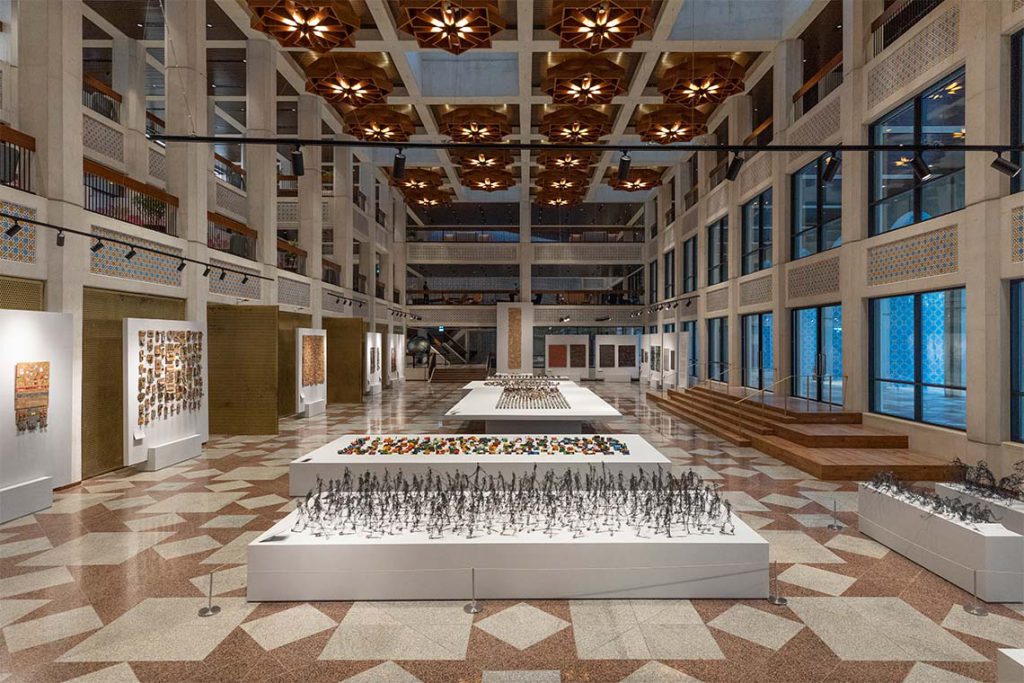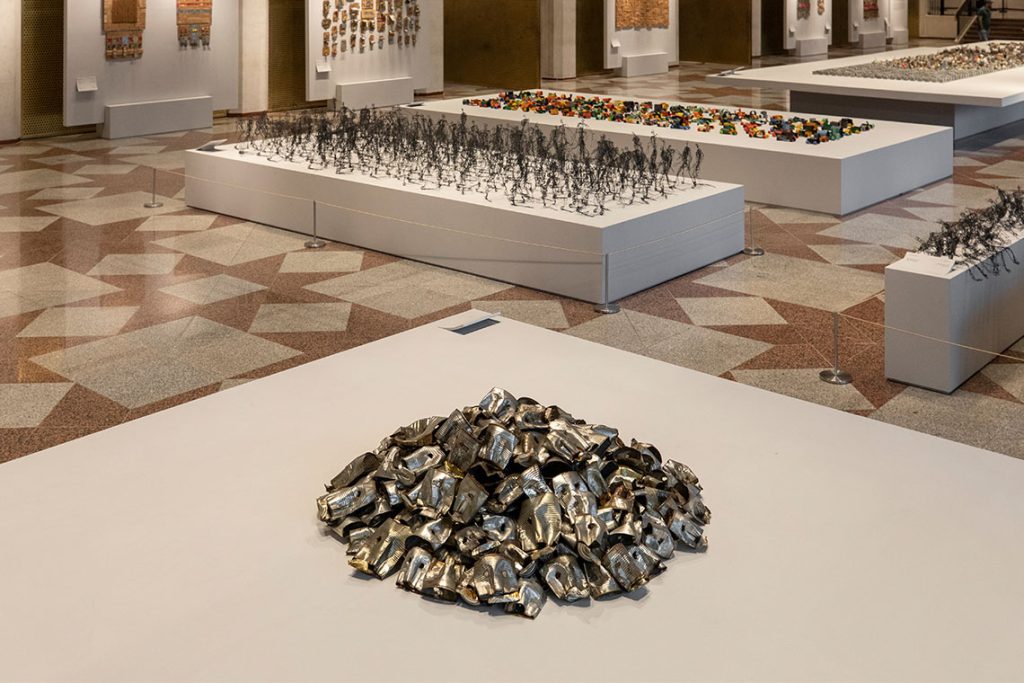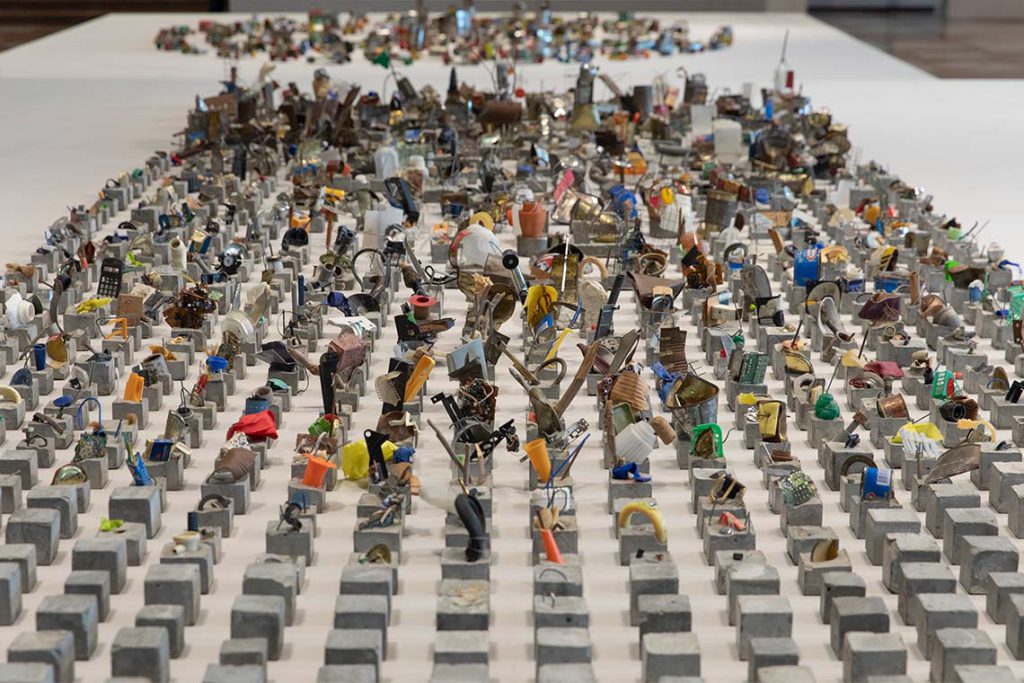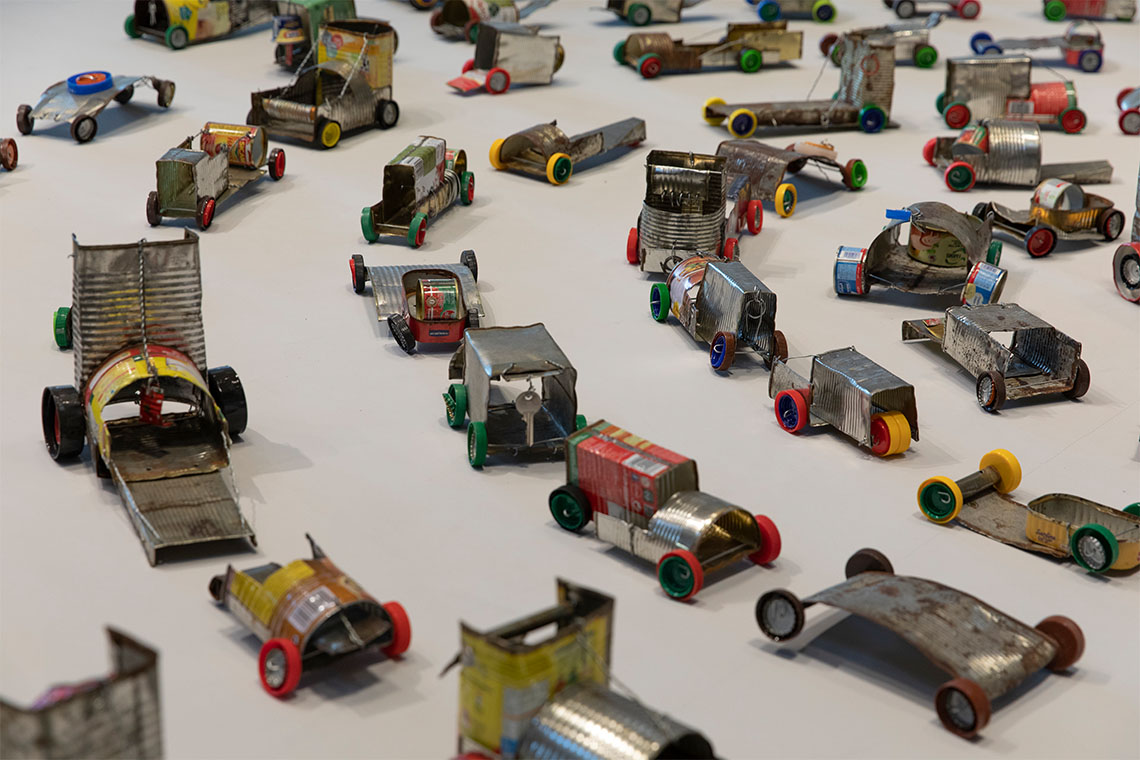In the pioneering Emirati artist’s latest exhibition, Re-framing Reality at the Cultural Foundation Abu Dhabi, Hussein Sharif addresses the hectic state of modern-day life through his unique treatment of raw materials.
When it comes to the genesis of the Emirati contemporary art scene, a few names immediately spring to mind. Among them are brothers Hassan and Hussein Sharif, two of the renowned “Five” pioneers – the others being Abdullah Al Saadi, Mohammed Kazem, Mohamed Ahmed Ibrahim – who forged their way from the 1980s onwards to carve a distinct and innovative artistic identity. It was an exciting and ground-breaking time, and one that is now rightly viewed as a defining moment in the development of the national artistic landscape.
The elder Sharif brother, Hassan, became celebrated internationally for his conceptual work and artful use of everyday objects, from zip fasteners to slippers and cotton mops. The younger Hussein, perhaps less widely known but equally active, is now the subject of the current exhibition, Re-framing Reality, curated by Aysha Al Hemeiri and Zuhoor Al Sayegh, at the Cultural Foundation in Abu Dhabi.

Image courtesy of Cultural Foundation, Department of Culture and Tourism – Abu Dhabi
This well-presented and thought-provoking show offers the welcome and long overdue opportunity to consider Hussein Sharif’s diverse practice. It brings together a variety of his works spanning a career of more than 40 years, executed from the early 1980s until the present day, and presenting his experimentation with painting, drawing, collage, found objects and installation art. Visitors are also offered a delightful insight into his dynamic artistic origins, backed by a display of archival material that includes art pamphlets from the 1980s and 90s.
During the mid-80s, Sharif was at the heart of the action in a nascent art and culture scene. He was a founder of one of the UAE’s first art magazines, Al Tashkeel, also studying theatre design in Kuwait and later working as head designer at Sharjah Television. Always demonstrating a keen visual eye, it was soon clear that making art would come to define his life.
Usually described as a postmodernist, Sharif creates work that serves as a commentary on modern-day consumerism and the changing urban landscape of the UAE – including at times an element of satire and humour. The exhibition catalogue gives an example of how Sharif placed popular foods, such as pizza and fruits, into images of serious subjects. He famously creates ‘something out of nothing’, which possibly helps explain the title of the show. For Sharif, it seems as if a metal can, a piece of wire, a scrap of magazine paper or a piece of cardboard are always more than what immediately meets the eye. He takes certain raw materials and carefully studies their form and character before manipulating them and forming narratives on the world around him.

Image courtesy of Cultural Foundation, Department of Culture and Tourism – Abu Dhabi
A major visual thread across Sharif’s pieces is the use of repetition, which can come across as an obsession, as if the artist is emptying his mind of certain thoughts and letting it all out on paper, canvas or concrete. One can see it everywhere, even on an old Arabic language newspaper spread, which he has filled it with endless blue markings. A whole section of the show is dedicated to his pen-and-paint drawings, which are small and intimate, featuring scribbled lines, mini squares and alphabet-like patterns. For these works, the exhibition text uses specific terminology, such as ‘system art’ and ‘structuralism’, to describe his process, which looks free-flowing but actually requires concentration, discipline and restraint.
Repetitive patterns can also be observed in his large abstract canvases, such as the black-and-orange-flecked Untitled (2021), mostly toned in intense, dark colours. Painting was Sharif’s entry point into art, where he was encouraged to “paint what you know, paint what you see, what is familiar to you and familiar to your community and culture”, according to the exhibition catalogue. There is also an element of pointillism, with the surface of the canvas dotted in an array of markings and patches, and where every gesture fits perfectly with each other, like a puzzle. In another display of paintings, the artist has created eye-catching images depicting traditional landscapes with triangle houses, but expressed in a modern, highly geometric way, marked with thick patches of paint.
The largest space in the exhibition displays Sharif’s generous installation pieces. In one corner is Faces (2021), a pile of compressed metal cans that show facial expressions, while another work, Figures (2003), is made up of an army of wire-formed figurines which walk in the same direction, as if they are protesting. There are also wall hangings of ‘carpets’, composed of vibrant food packaging and brownish cardboard. Sharif has also built scenes of busy urban life in which, for instance, a group of small cars (made of food tins and water bottle caps) stand close to each other in traffic.

The centre piece of the entire show is Sharif’s Cement Web from 2001. In a work akin to a cityscape or a concrete jungle, he has assembled rows made up of numerous small cement blocks that stand in straight lines. Half of this display comprises pure, ‘untouched’ grey blocks, whereas the blocks of the other half are colourful, cluttered with everyday items, such as a glue stick, a rusty cheese metal container and a plastic bottle. Apparently a visual reading of this installation is how the landscape of the UAE has drastically changed over time, and of the artist’s own experiences of this process, it also asks questions of its own, not least: Has it all been for better or worse?
Expansive and carefully considered, Re-framing Reality taps into topics ranging from the meditative to the architectural in an exploration of Sharif’s highly individual oeuvre, and particularly of his championing of raw materials. It also stands as a commendable tribute to an artist who has played a critical role in developing the contemporary art landscape of the UAE and wider region.
Hussein Sharif: Re-framing Reality runs until 1 September 2024



